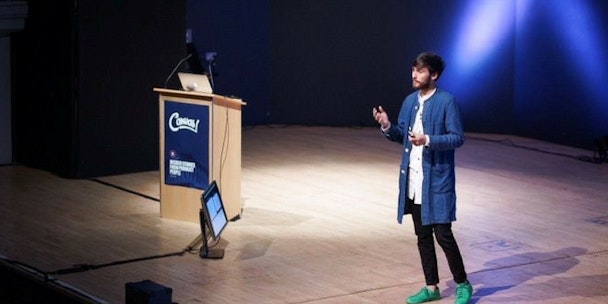Gamification is the key to Duolingo success says product manager Gilani at Canvas conference
Language education platform Duolingo boasts more than 200m subscribers worldwide and speaking today at Canvas, a product innovation and design conference held in Birmingham, Zan Gilani, associate product manager at Duolingo, puts much of that global success down to the company's four-pronged gamification strategy created to keep those users compig back for more.

Zan Gilani of Duolingo
Addressing 600 Canvas delegates, Gilani outlined how Duolingo has used gamification tactics more often seen on mobile games such as Candy Crush and Clash of Clans than in the realm of education to make Duolingo the most downloaded and used education app in the world.
Speaking of the platform's aim Gilani said: “It was the vision of our founders Severin Hacker and Luis von Ahn to create the very best language learning experience in the world and offer that free to anyone who wanted it, with the aim of doing away with the disparities that exist in our world, particularly when it comes to access to education.
“Motivating yourself to learn is very hard and learning a language is even harder, especially when you are doing that online on your own, so we realised early on that we needed to try to encourage people to form a daily learning habit. We found that the most effective techniques for this come from the gaming world.
After extensive research and lots of AB testing the company created a four-point gamification strategy, as Gilani explained: “The first part of that strategy is to enable our users to set themselves specific small concreate goals that they can achieve every day. Trying to learn an entire language is a huge nebulous goal that takes a long time to achieve. By breaking that goal down into smaller achievable daily goals or tasks we can encourage users to come back every day and to stick with it.
“The second point is that to continue to motivate the user to continue to learn their progress towards the larger goal has to be shown visually, so they can see that they are actually progressing and getting closer to their big goal.
“Thirdly users need external triggers to bring them back to the platform. We had to accept that people will leave the platform and we have had to devise and test the best way to bring them back and keep them engaged in the learning process. Emails and notifications proved to be the best external triggers and to encourage users to develop a daily leaning habit our testing showed that notifying them every 23.5 hours was the most effective timeframe to encourage regular daily use."
As Gilani explains, the real key to keeping users engaged is to encourage them to invest their own time in that learning process: “We have had to develop functionality to encourage users to invest their time in learning and we have created various rewards and incentives to do that. The key strategy, and one used by platforms such a Instagram, to keep users engaged is ‘The Steak’.”
“The Steak is a very powerful tool in forming a daily habit as you are rewarding and incentivising them for using the platform at some point everyday in the same way people maintain their streak of communications on Instagram for instance. Once they have started a streak people hate to lose them. Losing a streak is a horrible thing when it happens so we have created other achievement badges, which once earned are with the user forever.”
Gilani says that Duolingo has also introduced a range of incentives that can enable users to protect their streak, particularly at weekends, or ‘Streak-ends’ as the company refers to them internally, because Saturdays and Sundays are the days when most users habits do change and they can fall off the platform.
Other gamification tactics like introducing a non-monetary currency to the platform so users can be rewarded for consistent and regular use have also been introduced and Gilani says that AB testing and iterative changes will continue to roll out to further enhance the experience and to achieve the goal of the founders Hacker and von Ahn to create an education platform that will really change the world.
Organised by product innovation studio 383, other speakers at the Canvas conference, now in its sixth year, included product design and innovators Hamish Grierson of Thriva, Haiyan Zhang of Microsoft, Jane Kelly of BuzzFeed, Sarah Milton of All4, Bo Ren of Tumblr, Hugo Cornejo of Monzo and Emma Coats of Google.
Content created with:

383 Project
Experience Creators. Products Makers.
383 is a digital experience studio. We help the world's biggest companies to get fit for the future.
We're...

